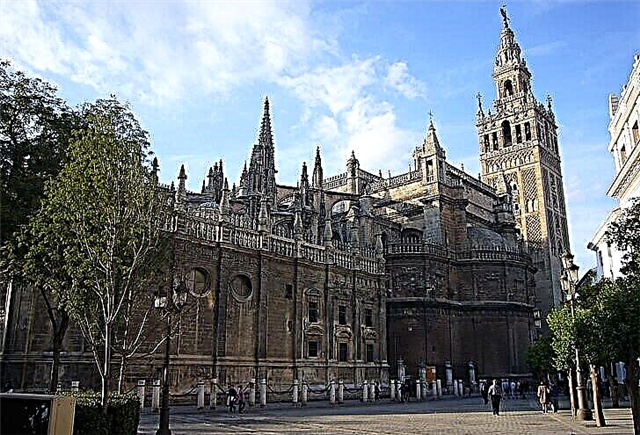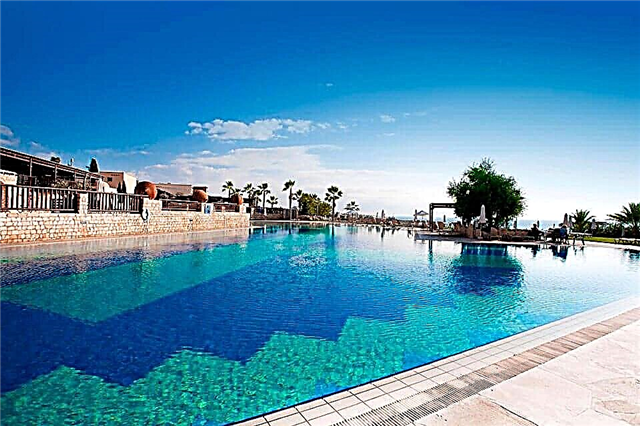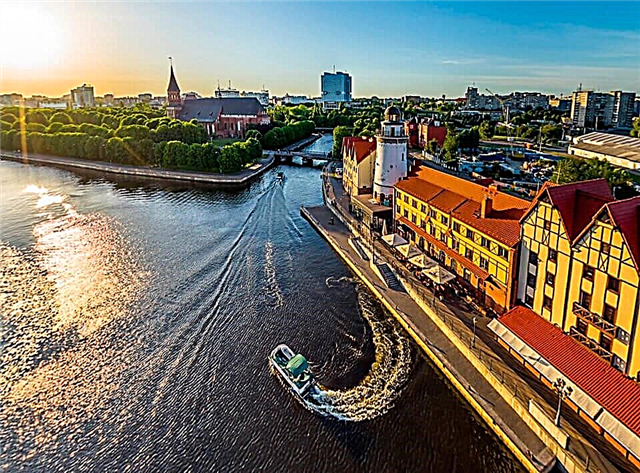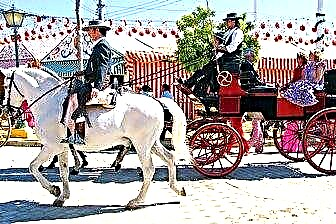Seville is the center of one of the most interesting and authentic Spanish provinces - Andalusia. Spectacular bullfighting and fiery flamenco were born here. The spirit of the Spanish south lives here and the ancient traditions of our ancestors are carefully preserved.
Seville was founded by the Phoenicians in the III millennium BC, then for a long time the city was a Roman colony. In the Middle Ages, it was under the protectorate of the Cordoba Caliphate. Many unique architectural monuments have survived from those times. Tourists can admire the Catholic temples built on the site of Moorish mosques, walk through the historic quarters and inspect the Arab towers on the banks of the Guadalquivir River. In the 17th century, Seville was the main port of the Spanish Empire. Expeditions to the New World sailed from here. In many ways, the modern architectural appearance of the city took shape at that time.

The best hotels and hotels at affordable prices.
from 500 rubles / day
What to see and where to go in Seville?
The most interesting and beautiful places for walking. Photos and a short description.
Spain square
The architectural ensemble of the square is located in the central part of the Maria Luisa Landscape Park, in the south of Seville. It was created in the 1920s. XX century for the opening of the Ibero-American Exhibition. The semicircular government building, as well as the numerous mansions that surround the square, are built in the Art Deco and Neo Mudejar style. In the middle there is a fountain surrounded by a small artificial canal.

Seville Alcazar
For several centuries, the Moors owned most of the Iberian Peninsula. Scattered throughout Spain are architectural monuments created during their reign or immediately after their expulsion. The Alcazar of Seville is a magnificent Mudejar-style fortress, the palace of the Sevillian rulers, built in the 14th century on the ruins of a defeated Arab fortress. And in our time, the royal family of Spain uses some of the premises of the palace as a personal residence.

Quarter Santa Cruz
The historic quarter that begins right at the walls of the Seville Alcazar. Initially, Jews lived here, but in the XIV century all local synagogues were converted into Catholic churches. Santa Cruz is an interweaving of narrow stone streets, vibrant colors of houses, lush Mediterranean vegetation and the incessant spirit of the past. The most significant city attractions are located here.

Triana quarter
A former gypsy quarter across the Guadalquivir River, where flamenco dancers lived predominantly. The place is distinguished by some chaotic development, noisy and cheerful atmosphere. There are many traditional tablao bars, where talented guitarists, singers and dancers perform in front of the audience. One of the central historical buildings of the quarter is the Carthusian Monastery.

Museum of Fine Arts of Seville
Picture gallery, which is considered one of the most important in Spain. Here you can admire the paintings of E. Murillo, J. Roelas, F. Zurbaran, G. Martinez. The museum was founded in 1835 in the building of the former monastery, which was confiscated by the state. The basis of the museum collection is made up of works of art that came here from churches and other religious institutions, therefore, the divine theme prevails in the exposition.

Archaeological Museum
The museum is located in the Maria Luisa Park. The building was erected by the architect A. Gonzalez in the Renaissance style, its construction was started in connection with the Ibero-American Exhibition in the 1920s. XX century. The museum collection contains several thousand artifacts found in the territory of Seville and the surrounding area during archaeological excavations.

Seville Cathedral
An imposing, picturesque temple that is considered one of the most beautiful Catholic cathedrals in the world. It was built in the 15th century on the ruins of a Moorish mosque. The project for the "construction of the century" was created by the architect A. Martinez. The work was completed at the beginning of the 16th century, but some elements of the cathedral's interior were completed only in the 20th century. Inside the temple is the grave of Christopher Columbus and the Castilian kings of the 13th-14th centuries.

Giralda tower
Moorish tower of the late XII century, erected during the reign of Caliph Abu Yugub Yusuf. Initially, the building served as a minaret for the city mosque. Later, the tower was adapted for the bell tower of the Catholic cathedral. In the 16th century, it was rebuilt in the manner of the Spanish Renaissance, designed by E. Ruiz. The tower reaches 87.5 meters in height; a gentle path leads to the top, intended for the passage of horses.

Basilica de la Macarena
A new church from the middle of the 20th century, erected on the site of a burnt church. Despite its small age, the building has already been recognized as a historical landmark. The architecture of the basilica is stylized in the traditional "Seville" Baroque, where a mixture of white and bright ocher prevails. There is a museum at the church, where the traditional clothes of bullfighters are exhibited, as well as many things related to the Spanish bullfight.

Church of El Salvador
Temple of the second half of the 17th century, built on the site of an Arab mosque. In the 18th century, the church was restored in the Churrigueresco (local Rococo) style according to the project of L. Figueroa. The building attracts attention with its ornate whimsical facade, painted in white and pink colors. The interior is distinguished by luxury, richness of decoration and wall painting. There is a magnificent altar in the church.

De los Venerables Hospital
The hospital was founded in the 18th century on the initiative of the religious Brotherhood of Silence. The building was erected in the Baroque style by the architects L. Figueroa and J. Dominguez - masters who made a great contribution to the appearance of Seville. The hospital was intended for old and already incapacitated church ministers. Due to lack of funding in the 19th century, it fell into disrepair. In 1987, the building was renovated with funds from the Seville Cultural Foundation.

Torre del Oro
A tower built by the Arabs at the beginning of the 12th century on the banks of the Guadalquivir River. Initially, there were two towers that stood opposite each other, but the second building has not survived. Torre del Oro was part of the fortress wall that surrounded Seville during the Moorish rule. The building has been perfectly preserved to this day. The tower was used as a treasury, a prison, an outbuilding. Now a museum is located on its territory.

Pilate's house
A 16th century palace built for the family of the dukes of Alcalá. The building bears some resemblance to the famous villa of Pontius Pilate. The main architectural style of the building is Mudejar with a mixture of Baroque. In the decoration, as well as in the appearance of the interior, Arabic motives are clearly traced. In the center of the building there is a picturesque courtyard with a fountain and lush greenery.

City Hall building
City Council building located in the central part of Seville. It is considered one of the most beautiful buildings in the city. The facade of the building is richly decorated with figural modeling, which depicts various mythological subjects. The City Hall was erected in the 16th century according to the project of D. Riaño. The building houses the city archive, which contains historical documents from the time of the Reconquista.

Palace of San Telmo
A grandiose 17th century palace built with funds from the Inquisition. The building was used as a school, royal residence and seat of the archbishop. Since 1992, the palace has been owned by the autonomous government of Andalusia.San Telmo is a prominent representative of the architecture of the late "Seville" Baroque. The monumental main entrance was added to the building later, in 1754.

Archive of the Indies
The Archive of the Indies is a unique repository of information about all the countless colonies that once belonged to the powerful Spanish Empire. It should be noted that her power extended from America to the Philippine Islands. The building was erected at the end of the 16th century according to the project of J. Herrera. More than 43 thousand volumes of historical documents are kept inside. In 1987, the archive of the Indies was listed as a historical heritage of mankind.

Royal Tobacco Factory
The complex was built in the 18th century according to the project of the Dutchman S. Van der Borcht. According to the master's idea, the building turned out to be very impressive and in terms of monumentality was second only to the famous Escorial. At one time, the factory employed several thousand women who produced tobacco products for all of Europe. It is here that the key scenes of Georges Bizet's opera Carmen unfold.

Maestrans bullring
The bullring, the construction of which lasted for 120 years (1761-1881) The entrance is decorated with statues of famous bullfighters. In the building of the arena there is a museum of bullfighting, where various attributes of this spectacle are exhibited, as well as old posters depicting the great matadors of the past. Among the exhibits there is a toreador's cloak painted by P. Picasso himself. The stadium can accommodate about 14 thousand spectators.

Metropol Parasol
A futuristic wooden structure located in the Place des Encarnación. The site was completed in 2011. Inside there is a terrace, museum, restaurants, shops and a farmer's market. Metropol Parasol is a whole cultural complex loved by locals and tourists. The structure reaches 28 meters in height, with a total area of several thousand square meters, which allows it to claim the title of the largest wooden structure in the world.

Alamillo bridge
Suspension bridge over the Guadalquivir River, built in 1992. The author was the famous architect S. Calatrava, who also worked on projects for an opera house on the island of Tenerife and on the Valencian City of Arts and Sciences. Alamillo is an engineering structure consisting of one strong support, which is balanced by 13 steel cables. The bridge is intended for motorists and pedestrians.

Maria Luisa Park
City park located in the southern part of Seville along the Guadalquivir River. It was laid out on the site of the palace gardens of San Telmo, which were donated to the public by the Infanta Maria Luisa Fernanda. The new park was named after the benefactor princess. At the beginning of the 20th century, the Ibero-American Exhibition was held here. By its opening, the park had grown significantly and acquired its modern shape.

Murillo gardens
Former royal gardens adjacent to the Seville Alcazar, now turned into a public park. The place is named after the famous artist - a native of Seville E. Murillo. The best masters worked on landscape design at the beginning of the 20th century. The alleys are decorated with sculptures, decorative fountains and gazebos. The gardens are located next to the historic quarter of Santa Cruz.

Magic Island Theme Park
A children's theme park that opened its doors in 1997. The opening took place in the presence of the Spanish king Juan Carlos. The park was originally conceived as the largest in Europe, its total area is more than 300 thousand square meters. On the territory there are extensive green areas, gardens, alleys, thematic squares where various shows are held. The theme of the park is the period of the Great Geographical Discoveries.

Seville Fair
An annual spectacular festival that has traditionally been held in Andalusia after Easter since the middle of the 19th century. The fair is attended by all residents of the surrounding area of Seville, as well as thousands of tourists from all over the world. This is a unique time when the Spaniards flaunt in traditional costumes, the counters are bursting with the abundance of local delicacies, and spectacular national shows are held every day. At the Seville Fair, you can feel the true spirit of Andalusia.

Flamenco
A unique art that combines dance, singing and play, originated in the south of Spain and has become its national treasure. Flamenco's origins date back to the ancient Moorish musical culture. They also incorporated a bright gypsy style (it is the gypsies who are considered by many researchers to be the founders of flamenco). In the 18th century, dance emerged from the darkness of semi-underground bars and firmly conquered the official stages and hearts of the Spaniards, and later the rest of the world.












